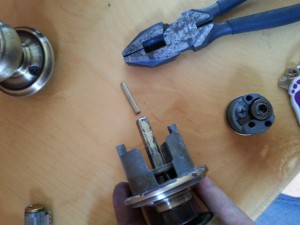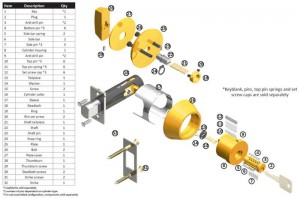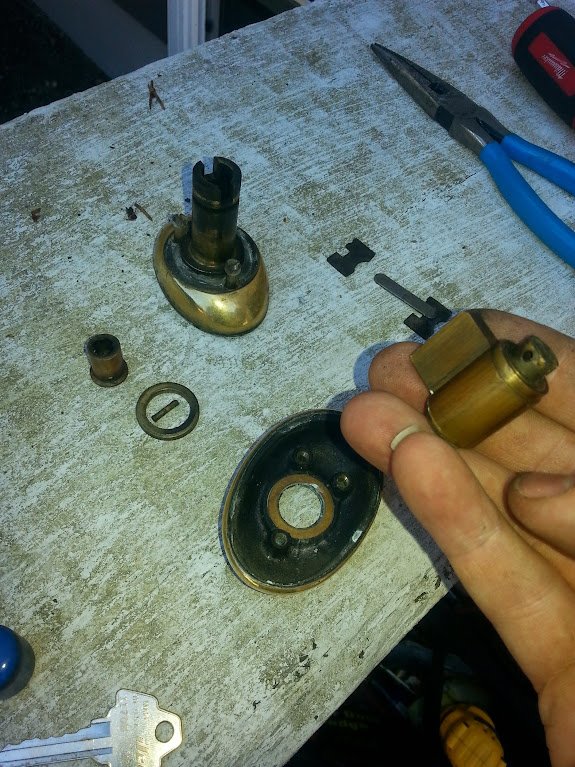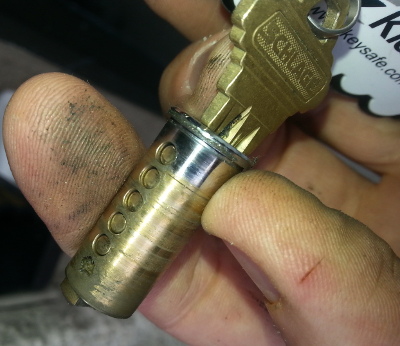If you own or manage a property that you must let people use, you are probably familiar with the idea of key control. You must give people keys that they can use but perhaps that they hopefully cannot duplicate. Ideally perhaps these people can only go into the property at certain times.
Some people in your situation as a property manager think it is suitable to simply have the locksmith who copies their keys stamp “Do Not Duplicate” on the head of the key for free, so as to save $.75 per key. I assure you, that is not sufficient. All the key holder needs to do is cover the stamped portion of the key head with any of a myriad of different colorful key identifiers. Then anybody will copy the key, or it can be copied in a key kiosk.
Similarly to the last problem, one can also distribute keys with neuter heads that say Do Not Duplicate in large letters. Even if those letters are ground off, the shape of the head tips off our locksmith that the key is not meant to be copied. This is a suitable key for low security situations. It is only good enough for low security because if the head is broken off the key and the cut portion taken to any locksmith he will duplicate that key onto a regular key blank which can be copied anywhere.
The other problem with a key that says “Do Not Duplicate” somewhere on it is that the cuts of the key can be easily measured using common calipers and then the original code cuts can be determined in minutes. Once this is done, any locksmith in the land will cut the key with the depths told to him over the phone.
The solution to controlling who has keys and preventing them from copying those keys is to use restricted keyways. When one locksmith controls your keyway and is legally bound to audit those he sells the keys to, you have a much better guarantee of security. The only way to copy a mechanical key with a restricted keyway is to spend a lot of time with a 3d copier or a milling machine and lots of time measuring. The bar is set much higher for obtaining unauthorized access to the properties you manage.
Of course, if one person is the salesman of your restricted keyway that is unobtainable anywhere else, you may expect the cost of the key to be a great deal more than a regular key. That is generally the case. Many locksmiths charge $10-20 for a high security restricted key. Of course, these keys also have higher costs for the locksmith who passes these costs on to you.
If you are interested in getting high security restricted keys I am a dealer of the CX-5 restricted keyway lock cylinders, and I can supply you with keys at the bargain basement price of $5 each. That is a screaming deal for a restricted key to a high security cylinder with a sidebar. If you do the math, it would probably cost less to replace the Medeco cylinders and keys in your building with my CX-5 cylinders and keys than it would be to rekey the Medeco cylinders and buy all new keys. Each person you need to get a key for represents at least $7 savings in typical situations if you make the switch. Bottom line is that you will save a lot of money if you go with Maple Leaf Locksmith LLC.
Category: Blog
The Most Secure (and Least Secure) Cars
I like to read technology news and sometimes this news intersects with my work as a locksmith. Today I was reading about research (after reading it appears to only be speculation though) being done by men examining how secure or insecure automobiles’ internal data communications networks are. This may be shocking to some, but your car has a computer in it communicating with different parts of the car. The concern here is that somebody could be driving next to you on the freeway, dislike the bumpersticker on your car, and turn your car off using some app on his phone that exploits a bluetooth security hole in your car’s computer. The researchers go so far as to list which vehicles they think are the least and most secure. In the comments was a very interesting observation:
So what this guy is saying is that somebody with a thorough understanding of a modern car could walk up and take the tail light out, plug his laptop in, and unlock the doors and start the car! Even somebody without any understanding of these cars but access to the tools and instruction could do so; I can see a gang of car thieves with a really intelligent criminal mastermind running it giving his thieves tools and explicit instructions in a flip book format on how to steal expensive cars for him. Maybe that’s what this was all about?
All of these inroads made by computers in our lives seem to be generally for the better, making our lives easier, but there can be unforeseen consequences. That is why I remain leery of installing locks that can be accessed via the customer’s data network. I have read too many times of people bypassing firewalls or passwords and gaining access to people’s physical assets like their baby monitor, for example.
Turn Your Entry Knob Into a Passage Knob
 So you have an entry knob and you want to disable it for some reason? Maybe you keep locking yourself out or maybe you don’t want to pay a locksmith to rekey the knob since there is a perfectly good deadbolt just above it. This is the situation I found myself in today. My customer wanted to know if I could turn the Schlage knobs she had into passage knobs instead of buying new passage locks and also instead of rekeying the knobs to match the deadbolts. She didn’t want to keep paying $38 extra every time I came to rekey her rental house, and she didn’t want to buy new passage locksets.
So you have an entry knob and you want to disable it for some reason? Maybe you keep locking yourself out or maybe you don’t want to pay a locksmith to rekey the knob since there is a perfectly good deadbolt just above it. This is the situation I found myself in today. My customer wanted to know if I could turn the Schlage knobs she had into passage knobs instead of buying new passage locks and also instead of rekeying the knobs to match the deadbolts. She didn’t want to keep paying $38 extra every time I came to rekey her rental house, and she didn’t want to buy new passage locksets.
The solution to this is simple, for the type of lock that has a spindle going through the knob to a bit on the inside of the door where the knob can be locked by turning something. This includes most cheaper knobs that can be purchased and installed oneself at the hardware store. All one need do is cut the thin piece of metal off that turns back and forth inside the knob. You can see in the picture above where the cut must be made. Make sure the metal spindle is in the unlocked position before cutting it off because it will be pretty hard to turn after you cut it off. If you don’t have a key that operates it you will have to pick the lock.
Once you put the knob back on the door you will notice that the inside locking mechanism on the knob will spin freely. It will be impossible for someone to lock the door without the key. Of course, you could just buy a passage knob at the hardware store for fifteen dollars or so and save your locking knob for replacement parts or sell it to somebody else on craigslist. Or donate it to my efforts to secure the homes of those in need.
How to Choose a Bicycle Lock
There are lots of different bicycle locks and they all have pros and cons. For most people the choice is between a U lock and a cable lock with a padlock. Last night I went to a celebration of bicycle culture in Seattle called “The Dead Baby Downhill 2014”, a bicycle race and afterparty featuring jousts from tall bicycles and even tall unicycles (tall bikes are bikes that are made of two bicycle frames welded together, one on top of the other). As one might expect, there were hundreds of bicycles everywhere and some of the most enthusiastic cyclists around were there showing off their rigs. This gave me insight into what is popular among bicycle messengers and others who use bicycles a lot.
Bicycle enthusiasts know that their rides are common targets of thievery, and they know many of the up and downsides of the locks available. A lot of people don’t though, so here is a primer:
Many people think that U locks provide higher security than cable locks. That is somewhat true but also false. Many U locks can be removed more easily due to their inflexibility. All that one need do to remove these is go to Harbor Freight and buy a car jack and put it inside the U lock and slowly spread it apart. This is fast, silent and effective. These locks often have disc detainer style keys and are usually really hard to pick unless you have the picks for them, and even most locksmiths do not have these lockpicks in the USA. U locks are a good choice if you need to keep honest people and slightly dishonest people who don’t think things through very well from stealing your bicycle. They will prevent people with bolt cutters from taking your frame, though they will not protect both of your wheels unless you take one of the wheels off the bike and pass the U lock through the frame and both wheels. This is a little cumbersome. U locks will not stop people with bottle jacks or rotary cutting wheels though.
You can’t open Kryptonite locks with the plastic of a ballpoint pen anymore. This was caused by Kryptonite using springs that were all the same tension, and this was a vulnerability that was discovered before Kryptonite started using their tubular locks. They just didn’t do their research or forgot about it or something. Now there is variable tension in their tubular locks, but many of their locks now use disc detainer locks.
Cable locks have a different set of advantages and vulnerabilities. They are often steel braided cable which is easy to cut with bolt cutters. These can also be broken by picking the bicycle up and twisting it off, using the length of the bicycle as a sort of lever. This takes more time and is really suspicious looking though. Cable locks can not be bypassed using a bottle jack or car jack. They are also more difficult to pry off. They are quite easy to cut off with bolt cutters though as well as rotary cutting wheels or angle grinders. Cable locks are really good for locking your bicycle up if you have to run into a building really fast. They weigh less and take up less space than a U lock. You can stick whatever kind of lock you like on a cable lock unless there is a built in lock. If there is a combo lock, there are ways to pick these I have learned from youtube videos and have had great success with. Cable locks are not good to lock your bike with overnight in sketchy areas. If you want to use a cable lock, get a longer one like twelve feet. This makes it more difficult to twist the cable into breaking because the thief would have to twist that much longer.
Sometimes it is hard to find something to attach your cycle to. It is easier to lock your vehicle up with a long cable because you can loop it around really big objects like trees if there are no signs or rails available. Remember: The bike is only as secure as what you’re locking it to.
Chains can be really secure if they are of hardened steel. You can buy a cheap length of chain from the hardware store but it will be easily cut through with boltcutters or even lineman’s pliers if the metal is soft and thin as most cheap chain is. Also chain from the store will scratch the paint on your bike. Unless you are willing to invest in a good security chain such as this Abus steel chain, you might as well get a cable lock. The security chains are really good. You can’t cut through them with most bolt cutters, it takes more time to angle grind them, and you can’t twist them off. They come with a sleeve to protect your paint. You can get them with integrated locks or use your own. They are a little heavy.
Don’t trust other people to intervene if somebody is stealing your bike. You can’t trust people in Seattle to do this, they are too passive, they don’t want to get involved in altercations. They will most likely walk right past. The most you can hope for is that they will use their iPhone to video the theft and post it on youtube.
The best thing to do is use some of these in conjunction with each other. Of course don’t overdo it, you don’t want to be bicycling around with ten pounds of locks and taking five minutes to lock up your bike every time you get to your destination. A U lock and a cable is a good combination of security though. The U lock will hold your bike down and the cable can be used to lock up your wheels and seat. It is a good idea to use a separate lock with the cable instead of threading the cable into the U lock. Attach the U lock to the bottom rail of the bike and put it through your back wheel. Attach it to something really sturdy, not just a chain link fence that can be cut with pliers. If you want to buy a high quality bicycle lock drop me a line, I sell the Abus chains. Don’t lose the keys because you will have to order those from the manufacturer if they are disc detainer keys.
CX-5 Locks: Higher Security, Low Cost, and I’m a Dealer!
I spent a lot of time researching which “high security” system I would buy into. I did this because the manufacturer often requires that you “buy in” to their system, meaning you might have to spend $15,000 minimum to get the hardware and their confidence. I didn’t want to blow this kind of money on just any system, I want a security product that provides my customers with very good security and great value. I had to weigh the strengths and vulnerabilities of each manufacturer’s offerings. I looked at Mul-T-Lock, Assa, Schlage, Medeco, and CX-5.
- One of Mul-T-Lock’s vulnerabilities among others is that with a certain kind of tape and a thin key one can bypass their locks, despite the brilliant engineering that went into their dimple keys and telescoping pin design.
- Medeco is just too expensive and their locks are finicky; they stop working when the smallest particle gets in the keyway. They are also not impervious to various methods of covert entry despite the hefty price tag.
- Schlage wants too much money for the Primus keyway and the cylinders wear out quickly. Schlage wants too much money for nearly everything they make. They charge me over $100 for an A series doorknob with a straight face. List price for an A series knob from my distributor is nearly $200, and that doesn’t include a cylinder! Also Primus keys are made of the same cheap brass that any key is, and these keys are vulnerable to breaking off in a lock if people are using the key to pull a door open. Of course, Medeco’s Keymark keys are also vulnerable to shearing. I like the Schlage Primus and its finger pin system a lot, but I want something less expensive. Property owners in Seattle with money to burn can already select from a wide variety of locksmiths with high-priced locks.
- CX5 is good enough. Reasonably high security, compatibility, not overly expensive, etc. CX5 cylinders have all of the same benefits that a lock cylinder three times the price has. CX5 cylinders exceed UL437 with hardened steel pins to prevent drilling, a sidebar, and they give me my own keyway that is geographically unique. To recap, CX5 has all of the physical security benefits of a Medeco or Primus cylinder, but for half the price. I pass on those savings to you.
 I know that many property managers think they are “locked in” to some of these proprietary high security systems because those are the locks they have on their doors. However, the cost of maintaining these systems may be greater than simply having me install the CX5 system once. Consider the cost of duplicating keys. Do you have to pay your locksmith to drive to your building for duplicates of your secure building key, or can you drive to them and save yourself $75? How much are you getting charged per key? Many locksmiths charge over $15 for a Medeco key. If you need over 100 keys, that adds up quick!
I know that many property managers think they are “locked in” to some of these proprietary high security systems because those are the locks they have on their doors. However, the cost of maintaining these systems may be greater than simply having me install the CX5 system once. Consider the cost of duplicating keys. Do you have to pay your locksmith to drive to your building for duplicates of your secure building key, or can you drive to them and save yourself $75? How much are you getting charged per key? Many locksmiths charge over $15 for a Medeco key. If you need over 100 keys, that adds up quick!
If your current locksmith is charging you to come out and duplicate keys and is overcharging you for the keys on top of that, you can see how it would quickly save you money to have me replace your Medeco or Mul-T-Lock cylinders with CX5 cylinders. My keys cost a lot less: only $8.50, and yet come with the same restricted key control as with the bigger names in security. The blanks are made of high quality nickel silver so they will stand up to a reasonable amount of abuse.
So next time you need your building’s entry locks rekeyed, save yourself some money and call me for an estimate. I can almost guarantee that it will cost you less to replace your cylinders with CX5 and distribute CX5 keys to all of your tenants than it will cost for your current locksmith to rekey and replace the current keys for your building, assuming you have some kind of protected keyway already installed. If you want something that is restricted but not “high security” in that it doesn’t have steel pins or a sidebar, ask me about installing MX cylinders for even greater savings!
Video of Lockpicking a Schlage F series Lever
A Strange Old Lock
I got called out for a rekey the other day and came across an interesting specimen, unusual for North Seattle. I don’t know what company manufactured it, just that the keyway was Challenger HO1 (so it was probably Challenger). To rekey it, I had to remove the whole lock off the door, something one need not do to rekey knob locks made in the last twenty years.
Once the whole assembly was removed in one piece from the door, it was time to remove a copper cover plate. Then I had to remove a cotter pin. Then a silver piece of metal that covered two more pieces of metal that retained the inner and outer knob. Once the outer knob piece was removed, I could pull the knob out. Then I had to drift out a roll pin to get at the cylinder. Finally a familiar sight: I took the plug out and rekeyed it. Putting it back together was harder. The knob didn’t want to go back in because of metal pieces that were in the way and difficult to manipulate, but once it was in and all the pieces were thoroughly tested, I put it back on the door with a latch protector (it was really easy to open this door with a credit card, there was no deadbolt, and this was the cheapest way to let the beautiful old lock remain in service). It only took 45 minutes to rekey but what a specimen!



How to Program/Reprogram Your Garage Door Opener
When I rekey a house people often ask me about how to change the garage door opener so that the old residents can’t continue using their remotes to open the garage door. To do this with a modern garage door opener you are doing more than simply changing the frequency like in the old days. It is now necessary to introduce your vehicle’s remote to your garage door opener, in a manner of speaking. Your car probably has a built-in remote, and you probably only need to push a program button on the opener in the garage and then hit your car’s remote button.
I can change the garage door opener and clear all of the old codes and add new codes, but to be perfectly honest I will do this by checking the manufacturer’s website for instructional pdf’s and then check your auto’s user manual. You would use the exact same steps to do this. There is no reason to pay me or anybody else to do this because it usually isn’t hard. With most modern garage door openers it isn’t as though you have to get out your soldering iron or deal with cumbersome dipswitches!
Following are some links to garage door opener manufacturer websites containing instructions for how to program the garage door opener yourself:
So, there you have it. Enjoy saving $100 and the satisfaction of doing it yourself, unless you still can’t figure it out and then you can call me.
Has Your Key Begun to be Unreliable?
Has your key been working great for years but slowly it has become harder to use? You may have to jiggle your key, pull it out slightly while using turning pressure, or put downward or upward pressure on the key to get it to turn?
If you answered yes to any of these questions, and the problem came gradually, the reason you are experiencing this problem is that your key and the pins in your lock have worn down. This may happen faster if the metal your key is made of or the metal the pins in your lock are made of is a harder metal than that the other is crafted out of.

The cheap fix is to take your key to your favorite place with a key copier and instruct them to shim the key up with some folded paper. This will replace the material lost over the years. It may not work as well as the key worked when the lock was first installed because the first pin in the lock will be worn down more than the last pin of the lock, just as the tip of the key will be more worn from wear than the part farthest from the tip. This is because when the key is inserted into the lock the tip of the key is pushed past every pin, and the first pin is forced up by every cut in your key. Therefore, ideally the key would be shimmed more at the tip to account for this uneven wear. It is not an exact thing. Fortunately, most consumer locks are not machined very precisely so a key can be about .015″ off on each cut and still work. I can copy your key to account for this uneven wear pattern.
The proper thing to do is to have a locksmith rekey the lock to match the key you have. The pins’ material should match that of the key. Longest life will be with a key that has the same material as the pins it touches, as anybody who learned about the Mohs hardness scale in middle school science class should realize. Most locksmiths use brass keys and brass pins, but some locks like Medeco or the CX-5 cylinders I sell use steel pins. If you use steel pins and a brass key, the key will wear down prematurely. If one saves the original key and always makes copies of it, then when one key wears out another can be made and the remedy is inexpensive.
If you are going to get your lock rekeyed, you might consider getting all of your locks rekeyed. Who knows where all of the copies of your keys might be?
Made a Key for a Boat
It is funny that, without a $0.25 piece of brass, a $50,000 yacht is just a giant floating paperweight. It’s also funny that an expensive yacht would use the same key as a cheap chinese file cabinet lock. Took me some time to impression because the ignition wasn’t fixed so it would move around while I was trying to mark the key blank, but I got it! Guy tipped me $25 and set off for Port Angeles.


I work in the automotive after market (ECU tuning). I can actually back up what they’re saying. Even if they did come by it via speculation, they’re actually pretty much dead on.
That is primarily because the german cars use what we call a “Can Gateway” but is better of though as a firewall. Every different system in the car has it’s own private canbus. Anything that needs to travel between the busses has to go through the gateway. In the case of VW/Audi vehicles, it’s locked down quite well. It knows what packets belong on what bus and only allows a very limited subset of properly formatted and required packets to pass between those busses.
Vehicles that share common can without a gateway are readily exploitable. I could plug a can interface into the headlights, A/C or any other system on the global bus and lock/unlock the doors, roll the windows up/down, trigger the traction control/ABS or even start/stop the car (if it uses a push button start).
Doing those things requires access to the can wires, but the bus is used for so much now-a-days, there’s always plenty of places to access it. Many of them without requiring keys or an open hood.